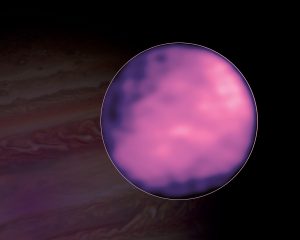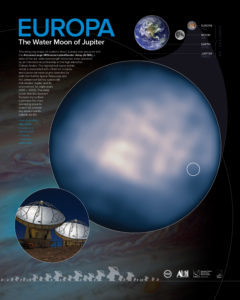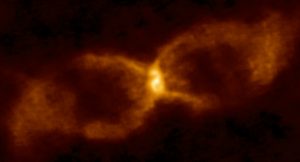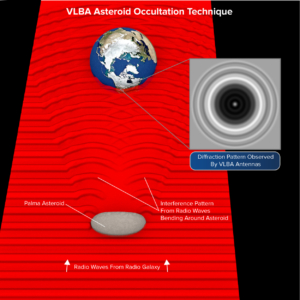Series of 4 images of the surface of Europa taken with ALMA, enabling astronomers to create the first global thermal map of Jupiter’s icy moon.


ALMA Observation of Europa
ALMA image of Jupiter’s moon Europa. ALMA was able to map out thermal variations on its surface. Hubble image of Jupiter in the background.

Europa, The Water Moon of Jupiter Poster
Downloadable poster of an ALMA observation of Europa. This intriguing image of Jupiter’s moon, Europa, was acquired with the Atacama Large Millimeter/submillimeter Array (ALMA), a state-of-the-art, radio-wavelength telescope array operated by an international partnership in the high elevation Chilean Andes. The highlighted region (white circle) is associated with a thermal anomaly and a potential water plume detected by both the Hubble Space Telescope and the unmanned Galileo spacecraft that studied Jupiter and its environment for eight years (1995-2003). The deep ocean that lies beneath Europa’s icy surface is perhaps the most promising place to search for present-day environments suitable for life.

Dwarf Stars Collide
Using ALMA, an international team of astronomers found evidence that a white dwarf (the elderly remains of a Sun-like star) and a brown dwarf (a failed star without the mass to sustain nuclear fusion) collided in a short-lived blaze of glory that was witnessed on Earth in 1670 as Nova sub Capite Cygni (a New Star below the Head of the Swan), which is now known as CK Vulpeculae.

Orphan GRB Discovered with VLASS
Series of radio images of FIRST J1419+3940 from 1993 to 2017 show its slow fade. Astronomers comparing data from an ongoing major survey of the sky using the National Science Foundation’s Karl G. Jansky Very Large Array (VLA) to data from earlier surveys likely have made the first discovery of the afterglow of a powerful gamma ray burst that produced no gamma rays detectable at Earth. The unprecedented discovery of this “orphan” gamma ray burst (GRB) offers key clues to understanding the aftermath of these highly energetic events.

VLBA Sees Diffraction Patterns Caused by Asteroid
Radio waves from a distant galaxy were blocked from view by an asteroid in our Solar System. However, in a process called diffraction, waves bent around the asteroid and interacted to form a pattern of bright and dark circles. Astronomers analyzed this pattern to learn new details about the asteroid’s. size, shape, and orbit.





